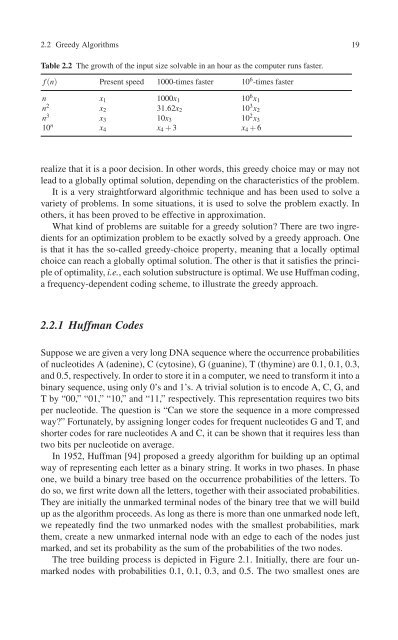Create successful ePaper yourself
Turn your PDF publications into a flip-book with our unique Google optimized e-Paper software.
2.2 Greedy Algorithms 19<br />
Table 2.2 The growth of the input size solvable in an hour as the computer runs faster.<br />
f (n) Present speed 1000-times faster 10 6 -times faster<br />
n x 1 1000x 1 10 6 x 1<br />
n 2 x 2 31.62x 2 10 3 x 2<br />
n 3 x 3 10x 3 10 2 x 3<br />
10 n x 4 x 4 + 3 x 4 + 6<br />
realize that it is a poor decision. In other words, this greedy choice may or may not<br />
lead to a globally optimal solution, depending on the characteristics of the problem.<br />
It is a very straightforward algorithmic technique and has been used to solve a<br />
variety of problems. In some situations, it is used to solve the problem exactly. In<br />
others, it has been proved to be effective in approximation.<br />
What kind of problems are suitable for a greedy solution? There are two ingredients<br />
for an optimization problem to be exactly solved by a greedy approach. One<br />
is that it has the so-called greedy-choice property, meaning that a locally optimal<br />
choice can reach a globally optimal solution. The other is that it satisfies the principle<br />
of optimality, i.e., each solution substructure is optimal. We use Huffman coding,<br />
a frequency-dependent coding scheme, to illustrate the greedy approach.<br />
2.2.1 Huffman Codes<br />
Suppose we are given a very long DNA sequence where the occurrence probabilities<br />
of nucleotides A (adenine), C (cytosine), G (guanine), T (thymine) are 0.1, 0.1, 0.3,<br />
and 0.5, respectively. In order to store it in a computer, we need to transform it into a<br />
binary sequence, using only 0’s and 1’s. A trivial solution is to encode A, C, G, and<br />
T by “00,” “01,” “10,” and “11,” respectively. This representation requires two bits<br />
per nucleotide. The question is “Can we store the sequence in a more compressed<br />
way?” Fortunately, by assigning longer codes for frequent nucleotides G and T, and<br />
shorter codes for rare nucleotides A and C, it can be shown that it requires less than<br />
two bits per nucleotide on average.<br />
In 1952, Huffman [94] proposed a greedy algorithm for building up an optimal<br />
way of representing each letter as a binary string. It works in two phases. In phase<br />
one, we build a binary tree based on the occurrence probabilities of the letters. To<br />
do so, we first write down all the letters, together with their associated probabilities.<br />
They are initially the unmarked terminal nodes of the binary tree that we will build<br />
up as the algorithm proceeds. As long as there is more than one unmarked node left,<br />
we repeatedly find the two unmarked nodes with the smallest probabilities, mark<br />
them, create a new unmarked internal node with an edge to each of the nodes just<br />
marked, and set its probability as the sum of the probabilities of the two nodes.<br />
The tree building process is depicted in Figure 2.1. Initially, there are four unmarked<br />
nodes with probabilities 0.1, 0.1, 0.3, and 0.5. The two smallest ones are

















